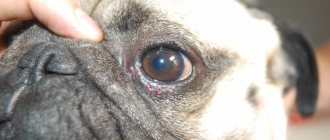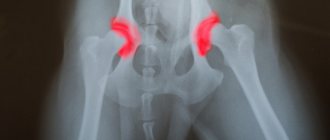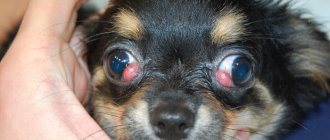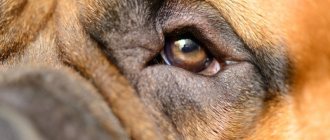In this article we will tell you about the occurrence, symptoms and treatment features of canine distemper (canine distemper, Carré's disease).
Some animal diseases can lead to serious consequences and even death. Canine distemper is notorious, the treatment of which is effective only with timely diagnosis. What is the causative agent of this dangerous disease, what varieties are found, how to recognize the symptoms and how is dogs treated for distemper? Our material will provide answers to many questions that trouble owners.
How does canine distemper occur?
The disease is classified as viral. The causative agent is a paramyxovirus from the genus Morbilliviridae. It is directly related to the human causative agent of measles and rinderpest virus. Observations of how plague manifests itself in dogs have been conducted since the 18th century. But it was only in 1905 that Carré confirmed the disease.
After the viral nature of the disease was established, it became possible to differentiate primary manifestations and secondary symptoms, and treatment of distemper in dogs became much more effective. It turned out that not only dogs, but also other predators (ferrets, foxes, wolves, minks) suffer from the plague. Therefore, in scientific literature it is called canine plague.
How is the diagnosis carried out?
A doctor will diagnose plague based on the following signs:
- a decrease in the number of leukocytes in the blood in the first week after infection;
- possible decrease in platelet count;
- nonspecific changes in tissues depending on the organ affected by the virus.
Did you know? Dogs
are
not the only animals that are affected by the distemper virus. Wild animals include raccoons, foxes, wolves, coyotes, skunks, ferrets, and minks.
Viral RNA can be detected in respiratory secretions, cerebrospinal fluid, feces and/or urine (depending on the location of the virus). But even a negative result does not mean the absence of a pathogen. Simply, samples can be taken when it is no longer excreted, but remains in the body. For example, in a dog that has been ill.
How do dogs become infected with canine distemper?
Sick animals (dogs or other predators) release the virus into the environment through discharge from the eyes, nose and mouth, as well as through feces, urine and dead skin epithelium.
The virus is very stable. It remains active in sunlight for 14 days and can survive for several days on clothing, on the floor or indoors. Therefore, disinfection of the premises where a sick or recovering animal is kept is of great importance. As with many other dog diseases, treatment of distemper should be accompanied by regular sanitary treatment of the premises. It is produced with a 2% solution of sodium hydroxide or other strong disinfectants.
Temperatures above 60 degrees can inactivate the virus within 1 minute, so to comply with quarantine, it is better to boil clothes and tools.
Healthy animals become infected from sick animals through food or air. You can also get infected from dogs that have already had the disease. They continue to be carriers of the virus for another 2-3 months even after treatment for canine distemper has ended.
How does canine distemper develop?
After the virus enters the body, the incubation period of the disease begins. It lasts 3-6 days. All this time, the virus multiplies in the tissues of the larynx and bronchial lymph nodes. The virus then spreads through the blood and lymph to the bone marrow and spleen, and the first symptoms of the disease appear. The temperature rises, the dog becomes lethargic and may refuse to eat. These symptoms of distemper in dogs are not yet specific and can be confused with manifestations of any other disease. Early consultation with a doctor and correct diagnosis can help quickly select an effective treatment regimen for canine distemper in a dog.
At this stage, the immune system actively counteracts the virus by producing antibodies. If for some reason (active colostral immunity or vaccination) the immune system takes over, recovery may occur. If the virus wins, it spreads further throughout the body. Treatment of canine distemper is complicated by specific symptoms. At this stage, the respiratory, digestive tissues, urethra and genitals, skin and nervous system are affected. During this period, all animal secretions become infectious and continue to remain so for up to 8 weeks. The effectiveness of treatment for canine distemper depends on the rate of formation of antibodies in the body of the infected animal and on effective medical support for the immune system. If a dog is sick with distemper, then an important medical task is to prevent secondary bacterial infections.
Clinical forms of canine distemper in dogs
The disease has a variety of forms, since the virus can infect any organs and tissues.
Gastrointestinal form of the disease (intestinal distemper)
It develops when the virus infects the mucous membrane of the stomach and small intestine. Vomiting, diarrhea (including bloody diarrhea), and rapid dehydration are among the most characteristic symptoms. If they occur immediately or together with respiratory manifestations, then this is a direct indication of intestinal distemper in dogs, treatment of which should be started as early as possible. The prognosis for treatment of intestinal distemper in dogs is cautiously favorable.
Respiratory form of the disease (pneumonic plague)
Pneumonic plague in dogs has symptoms similar to a bad cold. It is characterized by rhinitis (runny nose), difficulty breathing, and nasal discharge. The disease progresses rapidly, the discharge becomes purulent, and a crust forms on the nostrils. Next, bronchopneumonia develops, accompanied by a cough. A weakened immune system cannot resist numerous secondary pathogens, so infection with various bacteria is additionally possible: staphylococci, streptococci, bordetella. Pneumonic plague in dogs develops rapidly and quickly progresses to a severe stage. When pneumonia develops, the prognosis ranges from cautious to unfavorable.
Nervous form of the disease
This form of the disease most often occurs after the attenuation of the respiratory form or simultaneously with it. It occurs with meningitis and encephalitis caused by the canine distemper virus. There may even be temporary improvement lasting several days or even weeks. Nervous distemper in dogs is dangerous because it gives a whole range of different manifestations, depending on what part of the nervous system the virus has affected. Possible mental disorders, maneuvering movements, convulsions, tics, paresis, paralysis, blurred vision, blindness. The prognosis for treatment of the nervous form of distemper in dogs, which occurs without fever, may well be favorable, but tics can persist throughout the subsequent life of the animal. A severe course of the disease with a sharp increase in temperature and severe symptoms, as a rule, has a negative prognosis.
Cutaneous form of the disease
It manifests itself in the form of specific skin lesions: blisters filled with clear liquid appear on the skin. Bald patches may also be observed along the edges of the eyelids and near the corners of the lips. Canine distemper rarely occurs only in the cutaneous form; in this case the prognosis is favorable. But usually it accompanies the pulmonary or intestinal forms, which helps diagnose canine distemper in the case of nonspecific intestinal or pulmonary manifestations. If adequate medical care is not provided to a dog with cutaneous distemper in time, the disease may develop into a nervous form; in this case, lifelong disorders of the nervous system functions (tics, etc.) are likely to occur.
Pneumonic plague
The incubation period ranges from 3 to 10 days, on average 4-6 days, but can be reduced to one day. The course of infection is conventionally divided into three periods: initial, peak of the disease and terminal. The pathology manifests itself suddenly with a sharp rise in body temperature to 39-40° C. Symptoms of severe intoxication, headaches and muscle pain, weakness, chills, and vomiting are noted. Patients complain of shortness of breath, cough with the discharge of glassy transparent sputum. Often bothered by cutting pain, heaviness in the chest, tachycardia, conjunctivitis.
As the disease progresses, the nature of the sputum changes. It becomes liquid, bloody (with an admixture of scarlet or rusty blood), and when pulmonary edema occurs, it becomes pink and foamy. The discharge contains a large amount of pathogen. A picture of lobar or focal pleuropneumonia is formed. Scanty auscultatory data do not correlate with the patient’s serious condition. Objectively, hyperemia of the skin, puffiness of the face, injection of scleral vessels, the so-called “bloodshot eyes” are determined. The tongue is thickly covered with a white coating - as if “rubbed with chalk”.
At the height of the plague, symptoms of a disorder in the activity of nervous structures attract attention. At the initial stages, patients are excited or inhibited. As the pathology progresses, toxic encephalopathy develops. Speech becomes slow, slurred, coordination of movements is impaired, and sensitivity to sound and light stimuli increases. Various degrees of impairment of consciousness are formed, up to coma.
As a result of paresis of the vascular bed and impaired microcirculation, deviations in the cardiovascular system and acute renal failure occur. Cyanosis and chest pain increase, facial features become sharper, shortness of breath up to 60 per minute is detected. There is muffled heart sounds, tachycardia, and the pulse may be arrhythmic. The pressure drops sharply and is almost undetectable in the terminal period. Hemorrhagic syndrome is added. Areas with hemorrhages and petechiae are visible on the skin. Patients die from respiratory failure or severe hemodynamic disturbances.
Secondary pneumonic plague forms as a complication against the background of the main form of pathology. Symptoms of damage to the central nervous system, respiratory and vascular systems correspond to the above description. After an infection, stable cellular immunity is formed, but with massive infection, re-infection cannot be ruled out.
Distemper in dogs: symptoms and treatment
The symptoms of the disease, as we wrote above, depend on which organs and systems are affected by the disease, as well as on the individual characteristics of the immune system, the presence of other pathogens in the animal’s body and the type of virus itself. All of these factors influence how distemper manifests itself in dogs.
Therefore, the effectiveness of treatment for distemper in dogs depends on the stage at which the animal owner went to the clinic and the form of the disease. In general, treatment of dog distemper comes down to helping the immune system in its fight against the disease and correcting the changes that occur in the body under the influence of the virus.
Unfortunately, treatment of distemper in dogs often begins at a late stage, because at the time of the appearance of the primary signs - diarrhea, conjunctivitis, fever and refusal to eat, owners rarely consult a doctor. However, the combination of these signs should be a warning sign for the owner.
Symptoms of distemper in dogs, indicating the need for urgent medical attention for treatment: periodic fever, with an interval of two days to a week, purulent discharge from the nose and/or eyes, refusal to eat for more than a day, accompanied by lethargy, vomiting, diarrhea, cough that does not go away for more than a day. Owners of dogs that have not been vaccinated against distemper will have to monitor the symptoms and progress of treatment especially carefully.
Treating dogs for distemper often becomes an unexpected challenge for owners of very young dogs, whose immunity is not yet sufficiently developed and strengthened by vaccination.
Unfortunately, if a dog gets distemper, the symptoms of the disease may not be specific. Similar manifestations are observed in a number of diseases. Therefore, it is best to begin treatment of distemper in dogs by confirming the diagnosis. Modern veterinary laboratories use PCR analysis to diagnose canine distemper, which detects the presence of viral genetic material in a dog’s secretions.
The main regimen used to treat dogs for distemper is supportive and symptomatic treatment. In the first days, measures can be taken to support the immune system (introduction of ready-made antibodies in the form of serum or globulins). Antiemetics, medications to improve breathing, and IVs to correct dehydration are also prescribed. In case of severe disease with severe symptoms, treatment of distemper in dogs is best carried out in a specially equipped infectious diseases hospital.
Newest drugs for the treatment of canine distemper
If you need drugs for the treatment of distemper in dogs, you will find them in the assortment of Scientific and Production LLC. Today we offer to buy the drug fanniferon - antiviral and immune protection for dogs and cats. The drug has proven effective against the plague virus.
Buy ciprofan - to destroy a large number of gram-positive and gram-negative microorganisms in the animal’s body: Escherihia coli, Pseudomonas aeruginosa, Salmonella sp., Pasteurella sp., Staphylococcus sp., Streptococcus sp., Klebsiella spp., Bordetella bronchiseptica, Campylobacter spp., Corynebacterium spp. ., Erysipelothrix spp., Proteus spp., Mycoplasma spp., Brucella canis, Actinobacillus spp., Listeria monocytogenes, Haemophilus spp., Clostridium spp., Enterobacter sp., Chlamydia sp., , Bacteroides sp., Fusobacterium sp..
In the catalog on the website, study the specifications and instructions for all the drugs presented, and to clarify any details, contact the company’s managers by phone.
All drugs sold by the company are developed in its own laboratories, after which they undergo lengthy and thorough testing on animals. Only after this, medications begin to be produced and sent for sale. Our clients are large veterinary clinics and stores with which we cooperate on favorable terms.
What to do if your dog gets distemper
Treatment of dogs for distemper is best done under the supervision and support of an experienced specialist. This will make it easier to establish a diagnosis, control the severity of the disease, and monitor the dynamics of the disease.
We have already mentioned that treatment of distemper in dogs is often started too late precisely because of incorrect diagnosis. For example, owners note diarrhea and fever and give strengthening medications or simply put them on a diet. The dog may even feel better after the first stage of infection is over, but this does not mean recovery. As a result of delay, the disease progresses and enters a severe stage, when it is too late to provide help. Therefore, you should contact a specialist at the first alarming signs or at least have an idea about the symptoms of distemper in dogs so that treatment can be prescribed on time.
You think your dog has distemper - what should you do first? It is necessary to seek initial consultation and diagnosis as soon as possible. The animal should be isolated from other pets and the room where it is located should be disinfected twice a day.
After visiting a sick dog, you need to change clothes, wash and boil them thoroughly, and wash your hands.
Treating distemper in dogs at home requires following a special diet, also prescribed by a doctor.
Prevention of distemper in dogs
Competent and responsible dog owners will, of course, prefer prevention to the treatment of canine distemper. Fortunately, there is a vaccine for this disease.
The first vaccination is carried out for babies at the age of 8 weeks, the next one – after 3-4 weeks and then repeated annually throughout the life of the animal. If you picked up a dog on the street (or it came to you in some other way, and you do not know anything about its vaccinations), then it is better to quarantine the dog for 10 days without walking it on the street. This can be difficult, but it’s better than asking yourself the question later: how to treat a dog that has distemper.
If it is impossible to keep the animal in quarantine for any reason, emergency vaccination can be performed. But, nevertheless, it is better to carry it out in a calm manner, after 10 days of observing the animal.
It is necessary to understand that vaccination does not protect against the disease 100%. However, the immunity formed as a result of vaccination usually easily defeats the virus, so that symptoms of the disease do not appear at all, or appear in a mild form. Even in those rare cases when you need to see a doctor, the prognosis for treating distemper in a dog that has been vaccinated is favorable.
Manifestation of plague in dogs
In typical cases, the disease in dogs proceeds as follows. Approximately 4 days to 2 weeks after the dog becomes infected with the plague (incubation period), it notices general malaise, trembling, lethargy, the dog prefers to lie down more, decreased appetite, red eyes, fever (normal temperature in dogs is about 38°C in the groin).
This can continue for 2 - 3 days. Then the dog usually develops either gastrointestinal disorders - vomiting or diarrhea, and often both at the same time, or pulmonary symptoms - coughing. The redness of the dog's eyes becomes even stronger, and the ocular discharge takes on the appearance of pus. Purulent fluid is leaking from the dog's nose.
On the dog’s stomach and on the dog’s inner thighs one can often find a special skin lesion, which consists of the appearance of pustules of varying sizes in these places, sitting very superficially and surrounded by a red border. These pustules - pustules - initially have transparent contents and are very similar to blisters from a burn. Their size sometimes reaches the size of a human fingernail.
In more rare cases, such damage to the dog’s skin spreads to other parts of the dog’s body, where the pustules, due to the presence of hair, no longer have such a sharply defined shape, but simply form weeping surfaces. The described pustules are very characteristic of canine distemper, but they may not be present, especially in adult dogs. It is necessary to treat a plague lesion in a dog only in cases where it affects areas of the dog’s body covered with hair, for example, the neck, sides, etc.
Thus, distemper disease in dogs is divided into separate forms: ocular form of canine distemper, gastrointestinal, pneumonic, etc.
Diarrhea in dogs often takes on a protracted nature and occurs with severe symptoms - the dog’s complete loss of appetite, completely liquid stool, often without even feces, consisting of only bloody mucus (disenteric stool).
The cough of dogs at the beginning of the disease is quite loud, expectoration of sputum is quite difficult, ending with gagging. Subsequently, the dog's cough becomes quiet, purely pulmonary, purulent nasal discharge appears and the dog's general condition worsens.










